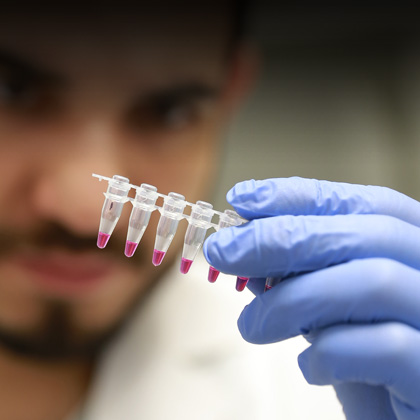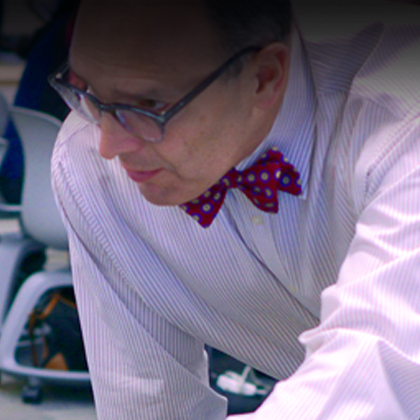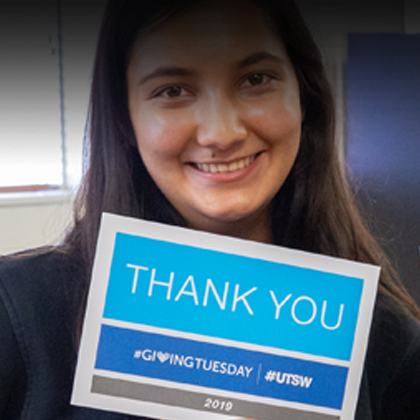Chasing The Next Big Discovery
What drives a scientist? It may be something as altruistic as a desire to cure cancer – or something more specific, such as solving the structure of a protein impacted in metabolic diseases.
At UT Southwestern, our unique collaborative culture and community of renowned scientists are often cited as reasons for research breakthroughs. This past year offered more proof of that impact, from approval of a first-in-kind drug to treat a rare disease to a finding that mechanical hearts can spur regeneration in failing hearts.
The year brought well-deserved recognition for our research, including a symposium celebrating the partnership of two Nobel Laureates, a Breakthrough Prize win, the election of faculty members to the National Academies of Medicine and Science, and receipt or renewal of significant grants for kidney cancer and obesity investigations.
Brown and Goldstein 50th Anniversary Celebration
UT Southwestern celebrated the 50th anniversary of the partnership of Nobel Laureates Michael Brown, M.D., and Joseph Goldstein, M.D., with a symposium hosting research from some of the world’s most elite scientists, many of whom credit the two investigators for inspiring their work. Hear from those speakers as well as UTSW faculty about the research duo’s contributions in this video. Also see highlights captured from the historic event in a photo gallery.
Recognizing Research Excellence

Masashi Yanagisawa, M.D., Ph.D., won the Breakthrough Prize in Life Sciences for discovering the cause of the sleep disorder narcolepsy. Dr. Yanagisawa, now a part-time faculty member, conducted the prize-winning work at UTSW. The award marks the third Breakthrough Prize for a UTSW scientist. Geneticist Helen Hobbs, M.D., won the illustrious prize in 2016, followed by biochemist Zhijian “James” Chen, Ph.D., in 2019.

Two UTSW faculty members were elected to membership in the National Academy of Medicine (NAM), one of the highest honors for American scientists. The inductions of Lora Hooper, Ph.D., Chair of Immunology, and Zhijian “James” Chen, Professor of Molecular Biology, grew UTSW’s total NAM membership to 18. Dr. Hooper specializes in research on beneficial bacteria, while Dr. Chen studies innate immunity.
UTSW geneticist Jonathan Cohen, Ph.D., was elected to the National Academy of Sciences (NAS), an illustrious recognition for U.S. scientists. Dr. Cohen, Professor of Internal Medicine, in the Center for Human Nutrition, and in the Eugene McDermott Center for Human Growth and Development, was elected based on his research that focuses on the roles of genes in metabolism. UTSW now has 26 members of the NAS, more than any institution in Texas.
For the third year in a row, UTSW is ranked as the top health care institution globally by Nature Index for publishing high-quality research in all subjects and in the life sciences. The Nature Index compiles affiliation information from research articles published in 82 premier science journals.
UTSW is designated one of 12 elite Nutrition Obesity Research Centers in the nation. More than 150 scientists from across dozens of departments in fields from metabolism to genetics will be part of the National Institutes of Health-funded research center supported by $6.15 million in grant funding over five years.
The National Cancer Institute renewed UT Southwestern’s $11.5 million program of excellence award in kidney cancer. The SPORE grant, first awarded in 2016, is one of only two SPOREs in kidney cancer nationwide aimed at accelerating the translation of discoveries to the clinic.
UTSW ranked fourth in the nation and No. 1 in Texas for commercializing new biomedical technologies, considered a critical step in bringing laboratory discoveries into clinical practice. UT Southwestern was the only Texas institution in the top 10 of the rankings, released by the economic think tank Heartland Forward.
Innovating science
- Cryo-EM imaging of protein reveals new binding pocket
Imaging at near-atomic resolution of the protein STING revealed a binding site that appears to be pivotal for launching immune attacks. The findings, published in Nature, could lead to new ways of manipulating STING to prompt stronger immune responses. Xuewu Zang, Ph.D., Professor of Pharmacology and Biophysics, and Xiaochen Bai, Ph.D., Associate Professor of Biophysics and Cell Biology, led the research.
- International team solves longtime structure mystery
A study published in Nature Structural & Molecular Biology is the first to solve and model virtually the entire structure of seipin, a transmembrane protein essential for proper fat storage. The study by Joel M. Goodman, Ph.D., Professor of Pharmacology, also pointed to the mechanism for birthing lipid droplets used for fat storage in healthy cells. Use of cryo-EM microscopy enabled the team to solve the previously elusive structure.
- Decades of research pave way for drug to treat rare muscle disease
A first-in-kind immune-modulating drug that arose from decades of basic research at UT Southwestern was approved as a new treatment for adults with myasthenia gravis, a rare autoimmune disease characterized by muscle weakness. The drug arose from basic research at UTSW by former faculty member E. Sally Ward, Ph.D.
- Nanotherapeutic drug to ward off liver cancer (in mice)
Researchers have developed an innovative nanotherapeutic drug that prevents cancer from spreading to the liver in mice. The new microRNA drug, developed by a team led by Andrew Wang, M.D., Professor of Radiation Oncology, is a promising candidate for drug companies that developed messenger RNA vaccines for COVID-19. The findings are published in Cancer Research.
- Study finds mechanical hearts can regenerate some heart tissue
Mechanical hearts spur some regeneration in dormant parts of failing hearts, according to a UT Southwestern pilot study that shows promise for developing regenerative heart therapies. Hesham Sadek, M.D., Ph.D., Professor of Internal Medicine, Biophysics, and Molecular Biology, reported in Circulation that left ventricular assist devices showed metabolic reactivation in myocardial areas that had little or even no activity.
- Protein prompts mature brain cells to regenerate multiple cell types
A single protein can reverse the developmental clock on adult brain cells called astrocytes, morphing them into stem-like cells that produce neurons and other cell types. These findings published in PNAS by study lead author Chun-Li Zhang, Ph.D., Professor of Molecular Biology, might someday lead to a way to regenerate brain tissue after disease or injury.
- Timing reduced-calorie meals dramatically extends life span in mice
A study in Science shows that it’s not just calories that count. Timing feedings to match the active period of the circadian cycle extended the life span of lab mice more than three times as much as caloric restriction alone, according to the research, led by Joseph Takahashi, Ph.D., Chair of Neuroscience, and Carla Green, Ph.D., Professor of Neuroscience, both members of the Peter O’Donnell Jr. Brain Institute.
- Genetic study confirms sarin nerve gas as cause of Gulf War illness
For three decades, scientists have debated the cause of Gulf War illness, a collection of chronic symptoms affecting veterans of the Persian Gulf War. A research team led by Robert Haley, M.D., Professor of Internal Medicine and Director of the Division of Epidemiology, solved the mystery, showing through a detailed genetic study published in Environmental Health Perspectives that the nerve gas sarin was largely responsible for the syndrome.
- How SARS-CoV-2 builds an RNA cap to perfect viral replication
UT Southwestern researchers identified how SARS-CoV-2, the virus that causes COVID-19, builds a structure called an RNA cap that’s critical for successful viral replication. The finding, published in Nature, could lead to new strategies to attack COVID-19. Author of the study is Vincent Tagliabracci, Ph.D., Associate Professor of Molecular Biology.
Growing a scientific enterprise
New leadership and research space support UTSW’s commitment to discovery


















